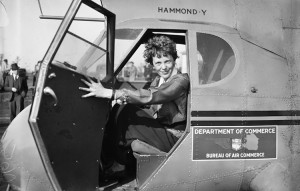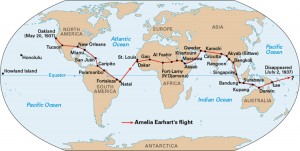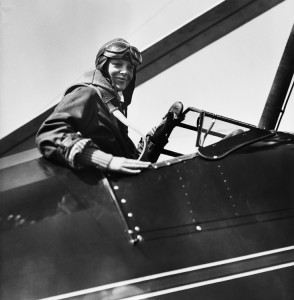Amelia Earhart: 80 Years Gone
July 5, 2017
In the first week of July 1937, 80 years ago, American aviator Amelia Earhart disappeared over the Pacific Ocean as she tried to become the first woman to fly around world. At the time of her disappearance, Earhart and her navigator, Fred Noonan, were flying the longest leg of their journey, a 2,600-mile (4,200-kilometer) flight over open sea. No trace was ever found of Earhart, Noonan, or the modified Lockheed Electra transport plane they were flying.

American aviator Amelia Earhart set many speed and distance records in aviation. In July 1937, 80 years ago this week, she disappeared over the Pacific Ocean while attempting to fly around the world. Credit: Library of Congress
Earhart’s attempted flight around the world—done at the longest possible distance, along the equator—captured international attention. The New York Herald Tribune relayed updates of Earhart’s progress to thousands of other newspapers as readers followed her roughly 27,000-mile (43,500-kilometer) journey. Her eventual disappearance over the Pacific Ocean shocked and saddened readers around the world.

Click to view larger image
Earhart and her navigator, Fred Noonan, began their around-the-world journey in Oakland, California, on May 20, 1937. Their route took them to Miami, Florida, across the Caribbean Sea and the northern edge of South America, over Africa and Asia to New Guinea. Earhart disappeared over the Pacific Ocean after taking off from Lea, New Guinea, on July 2, 1937. Credit: WORLD BOOK map
Amelia Mary Earhart was born in Atchison, Kansas, on July 24, 1897. Growing up, she lived in several Midwestern cities, eventually graduating from high school in Chicago. During World War I (1914-1918), she served as a volunteer nurse in Toronto, Ontario. In 1920, Earhart moved to California. While there, she became fascinated by aviation. Flying was a new and dangerous sport at that time. Earhart took flying lessons from an instructor named Neta Snook. Snook was one of only a few women pilots in the 1920′s. Earhart soon purchased her first airplane, a bright yellow biplane she called “The Canary.” In 1924, she moved to the East Coast. Earhart became a social worker in 1926, but she continued to fly. In 1928, Earhart rode as an observer on a transatlantic flight from Trepassey Bay, Newfoundland, to Burry Port, Wales. The flight made her famous as the first woman to cross the Atlantic Ocean by airplane.
In 1929, Earhart helped found the Ninety-Nines, an international organization of women pilots. In 1932, Earhart became the first woman to fly solo across the Atlantic (American aviator Charles Lindbergh was the first pilot to cross the Atlantic alone, in 1927). Earhart went on to set other speed and distance records, and she became an important figure in the development of commercial aviation.

Amelia Earhart, a pioneering American aviator, became the first woman to fly across the Atlantic Ocean alone. Earhart, shown here in the cockpit of an airplane, undertook the flight in 1932. Credit: © Corbis/Bettmann
In 1936, Earhart acquired a specially built Lockheed Electra transport that included such features as extra gas tanks, an automatic pilot, deicing equipment, a radio homing device, and a two-way radio. She called the plane her “flying laboratory.” Earhart then started planning a voyage that, if successful, would make her the first woman to fly around world (American aviator Wiley Post had done it alone in 1933).
In March 1937, Earhart made her first attempt to fly around the world from east to west, starting in Oakland, California. But she changed plans after crashing her plane in Hawaii. The plane was shipped back to California for repairs and adjustments. On May 20, Earhart and her navigator, Fred Noonan, took off again from Oakland, but this time they headed east to Miami, Florida. On June 1, with much fanfare, Earhart and Noonan left Miami to circle the globe. Their first stop was Puerto Rico. Their flight plan then took them to South America, Africa, Asia, Australia, and the island of New Guinea. At that point, they had completed about three-fourths of their planned flight around the world.
On July 2, Earhart and Noonan left New Guinea bound for Howland Island, a tiny atoll located almost halfway between Australia and Hawaii. The next morning, a U.S. Coast Guard vessel picked up radio messages from Earhart saying she was low on fuel and “running north and south” (searching for the island). No further contact was made. An extensive search found no trace of the plane or crew, and they were reported lost at sea. There have since been many theories and wild guesses at what happened to Earhart and Noonan, but the most probable explanation is that they simply ran out of fuel and crashed into the ocean.


